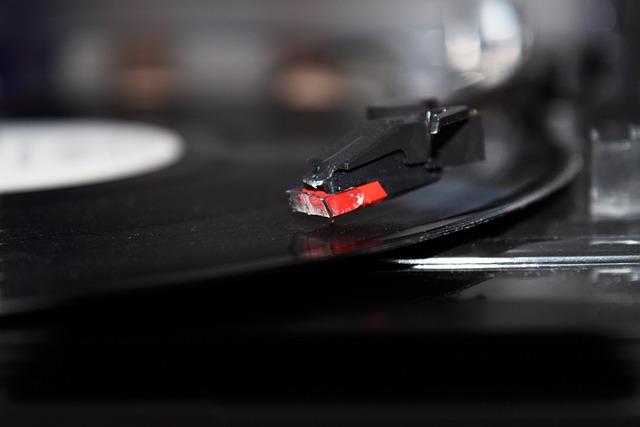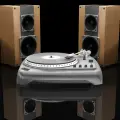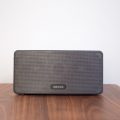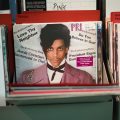When the needle drops on a vinyl record, one tiny component does the heavy lifting – the phono cartridge’s stylus. As this tiny tip rides within the grooves, it conjures the music we love. Yet its shape greatly affects sound quality and record wear. So, what are the differences between a basic spherical stylus and an elliptical? What about more exotic options like Shibata or micro-ridge?
This definitive guide breaks down all the major turntable stylus types in simple terms – no audio jargon allowed! We’ll explore the pros and cons of shapes spanning affordable conicals to van den Hul Legends. Terms like compliance demystified. And how materials influence longevity. Everything you need to discover your perfect listening experience. Shall we spin?

Table of Contents
What is a Turntable Stylus and What is its Purpose?
A turntable stylus, also called a phonograph needle, is a crucial component in a record player. Shaped like a tiny spearhead and made of incredibly hard material like industrial diamond, the stylus is mounted to the end of the tonearm’s cartridge. As the vinyl album spins, the stylus rides within the record’s grooves, picking up microscopic vibrations and transducing them into electrical signals that can be amplified and played through speakers.
The Stylus and Cartridge
The stylus attaches to the cantilever, which transfers movements into the cartridge – a removable module housed under the tonearm that contains the stylus and generates the electrical signals. The cartridge houses wires that relay this signal out of the tonearm and towards the preamp. The preamp boosts this weak signal so it’s ready for the power amps and speakers.
Without this small but mighty stylus, your record player would be useless. Now let’s explore some of the most common stylus types…
Different Types of Turntable Stylus
As seen already, the stylus plays a profound role in sound reproduction and record preservation. They come in a variety of shapes and structures, each with its own impacts on audio quality, vinyl wear, pricing, and intended applications.
Time to explore some species up close!
Elliptical Stylus
Of all the most common stylus types, the elliptical is arguably the best all-around choice for the average vinyl enthusiast. As the name suggests, elliptical styli have an oval shape and are a smart compromise between spherical and more aggressive conical profiles.
Ellipticals first came into prominence in the 1970s as high-fidelity cartridges gained popularity. Their defining oblong form allows for excellent contact with the record’s L/R stereo groove walls while minimizing excess wear compared to sharper shapes.
When examined under a microscope, the walls of a record’s grooves exhibit clear curved striations – almost like the grooves on a fingerprint. An elliptical’s flattened surface hugs these walls tightly, enabling excellent tracking while maintaining ample groove clearance to avoid damage:
- Wider groove contact area = higher fidelity stereo reproduction
- Finer shape than conical = less record wear
This makes ellipticals well-suited for the high fidelity needs of home listening without destroying your precious vinyl during repeated plays. No wonder it became the de facto choice of mid-range cartridges for decades!
Beyond solid fidelity and record care, ellipticals also hit a nice price-to-performance sweet spot, with quality options starting around $50-100. Coupled with their smart balanced design, this explains why elliptical styli continue to dominate modern mid-fi phono cartridges the world over. An old favorite that keeps on spinning!
Spherical Stylus
The spherical stylus, as the name suggests, has a rounded ball shape and is the most basic and affordable option. Sphericals dominate cheap beginner cartridges and remain popular as a kind, budget-friendly choice for worn records.
That smooth, rounded profile helps preserve vinyl by spreading contact over a wider groove area vs. sharper profiles. So, if you have a treasured but worn collection, a spherical can keep it spinning longer. Their high compliance also handles warped records nicely.
However, spheres suffer compromised high-frequency reproduction, unlike ellipticals that hug the groove walls. Spheres just skim the center, failing to extract higher stereo edge encoding. Don’t expect abundant sparkling detail!
Another niche where spheres thrive is DJ use. Their kind profile offers lower record wear during backcueing scratches. And since beatmatching focuses more on rhythm than fidelity, spheres work fine. Just don’t expect an audiophile experience.
In summary, affordable sphericals suit worn records, digitization, or basic DJ use rather than critical listening. They trade fidelity for vinyl preservation. Just set expectations accordingly and they offer a viable niche!
Conical Stylus
The conical stylus lives up to its name with a rather triangular, cone-shaped tip. This makes it one of the more aggressive profiles that prioritizes tracking ability over record care or sonic perfection. Conicals deliver reasonable audio quality with high tracking force to muscle through damaged spots – an appealing combo for DJs and worn vinyl fans.
Conicals exhibit a stiff cantilever suspension – perfect for taming warped vinyl. And their strong diamond wedge plows through accumulated gunk or small scratches during playback. So if you have a treasured but battered record collection, a budget conical cartridge can keep it alive. Just know your fidelity may suffer.
Of course, that triangular spearhead also damages records with repeated plays compared to rounder alternatives. So use caution with collector’s items! Conicals also require very precise setup and alignment to avoid skewed stereo reproduction.
Prime Choice for DJ Scratching
The high tracking ability has made conical styli a common choice for turntablist DJs over the years. Their strong tips withstand backcueing scratches well. And the focus stays more on rhythmic beatmatching rather than audiophile purity during performances. Just don’t expect heavenly listening sessions at home later!
In summary, the affordable conical offers a compelling balance for ripping through damaged spots on beloved records. Just be aware of the fidelity and vinyl wear tradeoffs compared to more refined modern profiles.
Shibata Stylus
The Shibata stylus stands as one of the most exotic and unique profiles ever conceived. Invented in the 1970s by audio pioneer Norio Shibata, its defining shape featuring a tall central ridge aimed to improve inner groove fidelity and channel separation beyond traditional options.
Today, Shibatas remain a top choice for discerning audiophiles seeking utmost resolution. However, their highly specialized structure comes with caveats…
Pinnacle of High Fidelity Playback
That central ridge allows the Shibata tip to contact both groove walls simultaneously – ideal physical stereo separation. And unlike traditional spherical or elliptical designs, the surrounding shoulders don’t obstruct the diamond’s bottom edge either. This grants the Shibata unmatched access to extract extreme high frequencies for spectacular clarity.
The long, thin profile also better navigates tight inner grooves near the record’s center. Reviewers describe the sound as supremely open and detailed. Almost like removing a veil between you and the recording! Suffice to say, Shibatas satisfy vinyl enthusiasts craving best-in-class playback.
However, the Shibata’s narrow dimensions mean even minute alignment errors introduce distortion. So they perform optimally only in high-end tonearms engineered for painstaking adjustments. Thankfully, modern turntable brands like Rega offer expertly-tuned packages with Shibata as an upgrade.
While niche, this pinnacle of stylus design wins hearts seeking pure fidelity without compromise. Let your ears rejoice!
Micro-Ridge Stylus
The micro-ridge stylus stands as a more recently developed exotic profile for audio perfectionists. As the name suggests, its ultra-fine tip features small horizontal ridges leading out to pointed contact edges. This novel form aims to improve high frequency extraction while minimizing record wear.
Leading vinyl brands like Ortofon now offer micro-ridge options in their top cartridge lines. Costly but capable!
Like a Shibata, the micro-ridge’s central ridges ride deep within the stereo grooves without obstruction. This grants unrivaled access to high frequencies near the lower boundaries of human hearing – intricacies that reveal subtle instrument textures and hall ambience cues.
Reviewers describe an abundance of fine sonic details previously unheard. The surrounding shoulders also hug the walls evenly to maintain proper channel separation. So if you crave hearing your treasured albums unveiled in full fidelity splendor, the micro-ridge warrants an audition!
Line Contact Stylus
The line contact stylus represents another modern exotic profile that aims to optimize fidelity through maximized groove wall contact area. As the name implies, its slim shape features elongated edges that ride perfectly flush within the record’s L/R stereo walls.
Leading brands like Audio-Technica offer line contact options in their flagship moving coil cartridge lines. The promise of detail beyond traditional tips comes at a cost though…
Pinpoint Fidelity
That sliver-thin contact patch allows the line profile to trace intricate groove undulations that spherical or elliptical designs might gloss over. Reviewers describe spectacular lucidity – almost microscope-like clarity cueing subtle room reverberations and fleeting instrumental textures.
The slim shoulders also avoid obstructing the diamond’s bottom edge for ideal access to high frequencies. So if you desire hearing favorite albums unlocked in vivid definition, the line contact warrants a dedicated listen!
Parallel Tracking Stylus
The parallel tracking (PT) stylus represents a unique breed designed for linear tonearms that move across records rather than pivoting from a fixed position. This straight, parallel tracking aims to eliminate distortion and record wear.
PT technology debuted in the audiophile world during the 1970s heyday. While costly, parallel tracking enjoyed renewed interest in recent decades as vinyl resurged. Companies like Clearaudio now offer such precision performers – for a princely price.
Unlike traditional tonearms, a parallel tracking design maintains perfect stylus alignment across the record from innermost to outermost grooves. This eliminates distortion called “tracking error” that can skew imaging. PT precision also means less record wear by avoiding unnecessary groove friction.
The result is a sonic and vinyl preservation boon – accurately extracting maximum fidelity with kindness to your delicate records during frequent spinning. Just be prepared to pay for such engineering overachievement!
Of course, the laws of physics still apply. So true aficionados employ meticulously engineered linear arms and cartridges paired with spotless platters and isolation to realize PT’s full potential. But for those so devoted, is perfect music playback not priceless?
Specialty Styli
While we’ve covered the most popular options, the world of phono cartridge styli contains some additional exotic species worth mentioning. Ultra-high-end audio brands like van den Hul, Lyra, and Clearaudio experiment with highly customized stylus shapes that promise further fidelity gains – for a lofty price.
Such boutique stylus offerings typically embed in equally specialized cartridges and turntables to target well-heeled audiophiles. A few notable examples include:
- The Pear-Shaped PA: Japanese engineer Tokunaga developed his signature PA (Projection Angle) profile featuring a rounded pear form with a single contact ridge. This shape aims for minimal record wear while allowing stiff cantilevers for optimized frequency response. B
- van den Hul Legends: One of the pioneers in exotic stylus innovation, van den Hul offers extensively hand-shaped tips like their Stradivarius line. The company keeps design details secret but focuses on diamond quality and custom profiling for unmatched resolution and longevity. Expect to pay dearly and pair with top-flight setups to realize the potential though!
While clearly not mass-market, these rare styli showcase master craftsmanship for fanatics.
Different Stylus Materials
The exotic shapes we’ve surveyed would be useless without being expertly formed from super-hard materials able to withstand the torture of riding record grooves. Diamond reigns supreme thanks to its unparalleled hardness, while some alternatives offer specialty properties.
Diamond – The Gold Standard
There’s a reason diamond stands timeless as the definitive phonograph stylus material. At a Mohs scale rating of 10 for hardness, diamond’s rugged and long-wearing strength enables thousands of plays before needing replacement – a miracle compared to early steel needles! Industrial-grade diamond also possesses the stiffness, polishability and uniformity critical to trace grooves with pinpoint precision.
When expertly machined into fine phonograph profiles, diamond extract every hidden atom of fidelity the vinyl master holds. Now that’s precious!
Alternate Materials
Other super-hard mediums sometimes used include ruby, sapphire, titanium, boron or beryllium. They often feature in exotic, hand-polished specialty designs or vintage gear. While lacking diamond’s supreme hardness, these alternate jewels offer positives like lower cost or high rigidity. Just ensure your precious vinyl gets a new stylus after the recommended lifespan!
How to Choose the Right Stylus
With so many stylus/needle options spanning shapes, materials, compliance, and costs, selecting the right one can feel daunting. Here are key considerations when balancing your budget, audio goals and record collection care:
- Match Your Turntable & Cartridge: Ensure compatibility with your tonearm’s cartridge first. Factors include movement type (MM/MC), mount standards, compliance needs, etc. Installation alignment also demands precision – missteps risk damage. Consider factory pre-mounted options or expert assistance.
- Prioritize Audio Goals: Detail fanatics may indulge in line contact or Shibata tips. DJs need durable conical or spherical profiles. Audiophiles balance resolution and record care with elliptical or micro-ridge alternatives. Also factor tracking ability for worn records and high frequency response. Identifying use case priorities helps narrow choices.
- Preserve Your Vinyl: Even budget elliptical options offer reasonably light tracking without excessive wear nowadays. But damaged records still warrant special treatment. Also factor lifespan costs – replacement diamond tips can save money long-term over cheaper sapphire.
In the end, balance your fidelity pursuits against real-world wallet limits and record collection goals. An audio journey of discovery!
Final Tones
There you have it – a guide summarizing all the essential phono stylus types for the vinyl aficionado. We’ve explored shapes spanning humble spheres to exotic Shibatas, learned impacts on sound and records, and applications from archiving to analytical listening.
Now comes tonearm setup, cartridge pairing and alignment finesse. But grasping stylus nuances grounds progress in tailoring that tiny terminus to unlock your personal vinyl vision – technically and emotionally. The stage is set: let newly informed perspectives guide deeper vinyl immersion!










